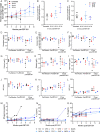Preclinical safety and biodistribution of CRISPR targeting SIV in non-human primates
- PMID: 37587230
- PMCID: PMC11090835
- DOI: 10.1038/s41434-023-00410-4
Preclinical safety and biodistribution of CRISPR targeting SIV in non-human primates
Erratum in
-
Correction: Preclinical safety and biodistribution of CRISPR targeting SIV in non-human primates.Gene Ther. 2024 Jul;31(7-8):434-435. doi: 10.1038/s41434-023-00438-6. Gene Ther. 2024. PMID: 38212405 Free PMC article. No abstract available.
Abstract
In this study, we demonstrate the safety and utility of CRISPR-Cas9 gene editing technology for in vivo editing of proviral DNA in ART-treated, virally controlled simian immunodeficiency virus (SIV) infected rhesus macaques, an established model for HIV infection. EBT-001 is an AAV9-based vector delivering SaCas9 and dual guide RNAs designed to target multiple regions of the SIV genome: the viral LTRs, and the Gag gene. The results presented here demonstrate that a single IV inoculation of EBT-001 at each of 3 dose levels (1.4 × 1012, 1.4 × 1013 and 1.4 × 1014 genome copies/kg) resulted in broad and functional biodistribution of AAV9-EBT-001 to known tissue reservoirs of SIV. No off-target effects or abnormal pathology were observed, and animals returned to their normal body weight after receiving EBT-001. Importantly, the macaques that received the 2 highest doses of EBT-001 showed improved absolute lymphocyte counts as compared to antiretroviral-treated controls. Taken together, these results demonstrate safety, biodistribution, and in vivo proviral DNA editing following IV administration of EBT-001, supporting the further development of CRISPR-based gene editing as a potential therapeutic approach for HIV in humans.
© 2023. The Author(s).
Conflict of interest statement
KK and RK are named inventors on patents that cover the viral gene editing technology that is the subject of this article. KK is a co-founder, board member, scientific advisor, and holds equity in Excision Biotherapeutics, a biotech start-up that has licensed the viral gene editing technology from Temple University for commercial development and clinical trials. THB holds equity and is a member of the scientific advisory board of Excision BioTherapeutics. The authors declare that this work was produced solely by the authors and that no other individuals or entities influenced any aspects of the work including, but not limited to, the study conception and design; data acquisition, analysis and interpretation; and writing of the manuscript.
Figures





References
Publication types
MeSH terms
Grants and funding
LinkOut - more resources
Full Text Sources

